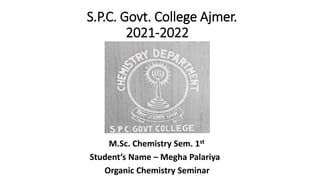Free Radical Reaction and It's Type
•Transferir como PPTX, PDF•
0 gostou•359 visualizações
Megha Palariya
Denunciar
Compartilhar
Denunciar
Compartilhar

Recomendados
Protection for carboxylic group & Protection for the Amino group

Protection for carboxylic group & Protection for the Amino groupCollege of Pharmacy,Sri Ramakrishna Institute of Paramedical Sciences,Coimbatore
Mais conteúdo relacionado
Mais procurados
Protection for carboxylic group & Protection for the Amino group

Protection for carboxylic group & Protection for the Amino groupCollege of Pharmacy,Sri Ramakrishna Institute of Paramedical Sciences,Coimbatore
Mais procurados (20)
Protection for carboxylic group & Protection for the Amino group

Protection for carboxylic group & Protection for the Amino group
Protecting and Deprotecting groups in Organic Chemistry

Protecting and Deprotecting groups in Organic Chemistry
Semelhante a Free Radical Reaction and It's Type
Semelhante a Free Radical Reaction and It's Type (20)
Reaction mechanism ppt for advance organic chemistry.pptx

Reaction mechanism ppt for advance organic chemistry.pptx
Organicreactionsandmechanisms 120331092608-phpapp01

Organicreactionsandmechanisms 120331092608-phpapp01
B.tech. ii engineering chemistry unit 4 B organic chemistry

B.tech. ii engineering chemistry unit 4 B organic chemistry
Mais de SPCGC AJMER
Mais de SPCGC AJMER (20)
Último
Último (20)
Module for Grade 9 for Asynchronous/Distance learning

Module for Grade 9 for Asynchronous/Distance learning
Biogenic Sulfur Gases as Biosignatures on Temperate Sub-Neptune Waterworlds

Biogenic Sulfur Gases as Biosignatures on Temperate Sub-Neptune Waterworlds
Human & Veterinary Respiratory Physilogy_DR.E.Muralinath_Associate Professor....

Human & Veterinary Respiratory Physilogy_DR.E.Muralinath_Associate Professor....
POGONATUM : morphology, anatomy, reproduction etc.

POGONATUM : morphology, anatomy, reproduction etc.
Bhiwandi Bhiwandi ❤CALL GIRL 7870993772 ❤CALL GIRLS ESCORT SERVICE In Bhiwan...

Bhiwandi Bhiwandi ❤CALL GIRL 7870993772 ❤CALL GIRLS ESCORT SERVICE In Bhiwan...
300003-World Science Day For Peace And Development.pptx

300003-World Science Day For Peace And Development.pptx
development of diagnostic enzyme assay to detect leuser virus

development of diagnostic enzyme assay to detect leuser virus
FAIRSpectra - Enabling the FAIRification of Analytical Science

FAIRSpectra - Enabling the FAIRification of Analytical Science
Genetics and epigenetics of ADHD and comorbid conditions

Genetics and epigenetics of ADHD and comorbid conditions
TransientOffsetin14CAftertheCarringtonEventRecordedbyPolarTreeRings

TransientOffsetin14CAftertheCarringtonEventRecordedbyPolarTreeRings
Asymmetry in the atmosphere of the ultra-hot Jupiter WASP-76 b

Asymmetry in the atmosphere of the ultra-hot Jupiter WASP-76 b
Free Radical Reaction and It's Type
- 1. S.P.C. Govt. College Ajmer. 2021-2022 M.Sc. Chemistry Sem. 1st Student’s Name – Megha Palariya Organic Chemistry Seminar
- 2. TOPIC- Free Radical Reaction And It’s Type
- 3. Content~ • Free Radical Introduction • Types Of Free Radical Reaction • Recombination • Disproportionation • Reaction With Olefin • Reaction With Iodine And Metal • Rearrangements
- 4. Introduction • When A Covalent Bond Undergoes Homolytic fission, The Two Departing Atoms Take One Electron Of The Binding Pair Of Electrons. The Two Fragments Produced Carry An Odd Electron Each And Are Called Free Radicals.
- 5. Reactions For Free Radicals 1). •Recombination 2). •Disproportionation 3). •Reaction With Olefin 4). •Reaction With Iodine And Metals 5). •Rearrangements
- 6. Recombination Reaction • The Free Alkyl Radicals May Recombine To Form Hydrocarbons. • Note- The Reaction Is Used In The Termination Step In The Free Radical Polymerization For The Production Of Polymers.
- 7. Disproportionation Reaction • At Higher Temperature The Alkyl Radical May Undergo Disproportionation. The Ethyl Radical Disproportionates (i.e. One radical takes Up hydrogen from Another free radical) • Note- It Is Found That Coupling Takes Place With Unbranched Free Radicals While Disproportionation Predominates With Brached Radicals.
- 8. Reaction With Olefines • The Alkyl Radicals Reacts With Olefins To Form A New Free Radical. • The Newly Formed Free Radical Further Add On The Another Molecules Of Olefin. • Note- The Above Reaction Is Used As The Propagation Step In The Polymerization Of Ethylene.
- 9. Reactions With Iodine And Metals- The Alkyl Radicals May Combine With Iodine or Other Elements To Form Alkyl Derivatives.
- 10. Rearrangements Like Carbanions,the Free radicals undergo rearrangements Involving 1,2-Shifts of aryl group via bridgehead intermediate.Thus, the Aldehyde 1). Undergoes H-abstration from the CHO group by Me3CO To yield the acyl radical. 2).Which loses CO to form the Radical. 3). The Rearrangement Involves the Migration of Ph via The bridged ion intermediate
- 11. Reference Book • Reaction Mechanism And Reaganets In Organic Chemistry- By Dr. G.R. Chatwal {Himalaya Publishing House} • Reactive Intermediates in Organic Chemistry: Structure, Mechanism, and Reactions- By Maya Shankar Singh • Advanced Organic Chemistry- By Dr. Jagdamba Singh, Dr. L.D.S. Yadav {A Pragati Edition}
- 12. ThankYou